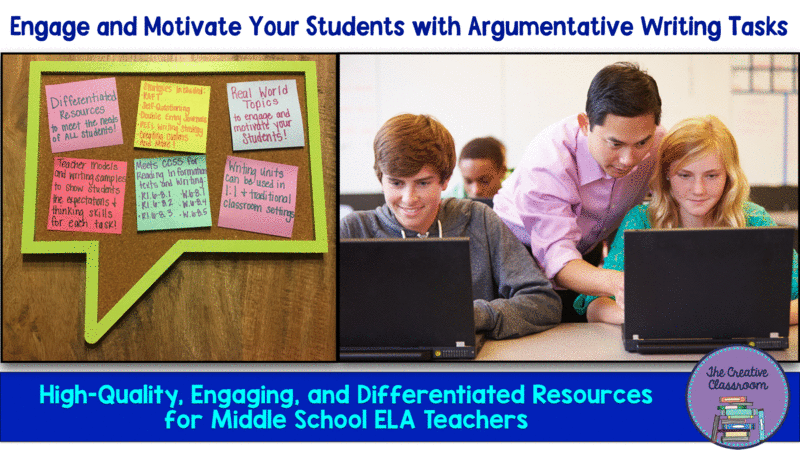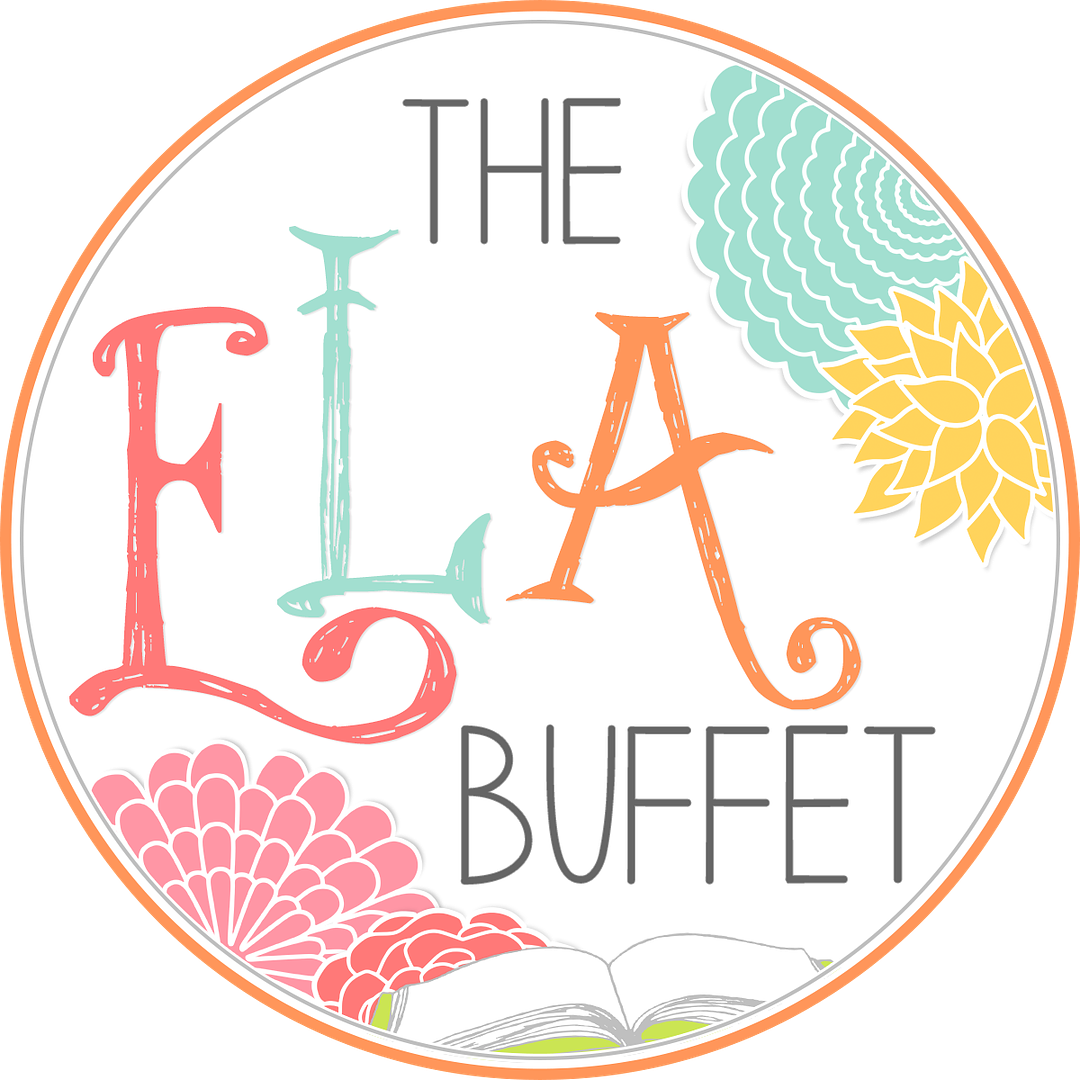When I first began teaching in 2008, I was hired to teach 6th-8th grade Literacy Enrichment for students who struggled in ELA. There was no set curriculum for this elective class and I was given complete creative control over what lessons I taught. As a brand new teacher, one would think that the idea of three separate preps with absolutely no curriculum resources would be completely overwhelming; however, I was elated that I would be able to introduce my students to some of my favorite authors, historical events, and real life learning opportunities. It felt like every dream I had about teaching had come true!
What I quickly realized was that my students struggled immensely with writing, which led to many of them either too embarrassed to put their thoughts into words or simply refusing to complete the assignment. I knew that I had to come up with a solution that would not only get my students interested and engaged in the content but would also allow them to experience success, which would help to motivate them. It wasn’t very difficult to come up with an idea to try in my classes.
Introducing My Students to Argumentative Writing
If you have ever taught middle school students, it doesn’t take long to realize that they are very opinionated and have no problem sharing their opinions with you. In fact, many of them not only loved to share their opinions, but would openly let others know when and why they disagreed with a differing opinion on any subject. I used this bit of knowledge to my advantage when I decided to introduce my students to argumentative writing.
I used three simple questions at the beginning of class to get my students curious and interested in the concept of argumentative writing. Once my students realized that I was going to teach them how to create ways to share their opinions on real world issues that were supported with evidence that people could not dismiss as simply being a teenager’s opinion they were hooked.
 I had achieved my first goal, but I also knew that creating and supporting arguments would be a difficult task for many of them to successfully complete. My students needed a trial run in creating arguments that I could use to identify trends in writing and individual student weaknesses to ensure that my future classroom instruction would be purposeful. For our first attempt, my students read an article from Scholastic Magazine entitled “You Danger”, which dealt with the debate on whether Youtube should be responsible for the repercussions of the dangerous videos that users post on the website. After we finished reading the article, my students engaged in the best whole group discussion that I had heard in my classroom all school year. They were using evidence from the article and their own personal experiences to support their opinions on who was to blame for the dangerous videos. I knew that they could verbally express themselves using the text and personal experiences, but could they translate that into their writing?
I had achieved my first goal, but I also knew that creating and supporting arguments would be a difficult task for many of them to successfully complete. My students needed a trial run in creating arguments that I could use to identify trends in writing and individual student weaknesses to ensure that my future classroom instruction would be purposeful. For our first attempt, my students read an article from Scholastic Magazine entitled “You Danger”, which dealt with the debate on whether Youtube should be responsible for the repercussions of the dangerous videos that users post on the website. After we finished reading the article, my students engaged in the best whole group discussion that I had heard in my classroom all school year. They were using evidence from the article and their own personal experiences to support their opinions on who was to blame for the dangerous videos. I knew that they could verbally express themselves using the text and personal experiences, but could they translate that into their writing?
As I predicted, many of my students struggled with creating a strong one paragraph argumentative response. The majority were able to state their position successfully and more than half of them were able to pull at least one relevant piece of text evidence to support their position, but very few of them were able to make connections or explain how their text evidence supported their position. I decided that since so many of them struggled with the one paragraph response that I needed to put on the brakes and find a strategy that would fix the issues my students were having.
Creating a New Game Plan
 Our school had been using the Better Answers Writing Strategy as a pre-writing tool to help students craft writing responses, but it was simply not helping my students with their arguments. They needed something that was more defined and broken down into smaller pieces. The PEEL Writing Strategy was just what my students needed! It closely resembles Better Answers, but it breaks the middle part into two pieces: evidence and explanation. I created a teacher model for the PEEL organizer and used it to introduce this pre-writing tool to my students. As I monitored student’s progress during their independent work time, there was an immediate difference in the quality of work. The breakdown of PEEL made writing expectations more clear for students and they were able to see the difference between a piece of evidence and explanations. There were still many issues that needed to be addressed before my students were ready to write a multi-paragraph response on their own, but I noticed an overall improvement in their revised argumentative response. The majority of responses were developed more with 2-3 pieces of relevant text evidence and attempts at explaining why that evidence was important. I made sure that when I was leaving feedback on their revised responses that I highlighted and praised them for their growth and improved writing more than focusing on the mistakes that were still present. I needed them to know that I was proud of the growth and effort that they had put in and that we would work together as a team to grow even more.
Our school had been using the Better Answers Writing Strategy as a pre-writing tool to help students craft writing responses, but it was simply not helping my students with their arguments. They needed something that was more defined and broken down into smaller pieces. The PEEL Writing Strategy was just what my students needed! It closely resembles Better Answers, but it breaks the middle part into two pieces: evidence and explanation. I created a teacher model for the PEEL organizer and used it to introduce this pre-writing tool to my students. As I monitored student’s progress during their independent work time, there was an immediate difference in the quality of work. The breakdown of PEEL made writing expectations more clear for students and they were able to see the difference between a piece of evidence and explanations. There were still many issues that needed to be addressed before my students were ready to write a multi-paragraph response on their own, but I noticed an overall improvement in their revised argumentative response. The majority of responses were developed more with 2-3 pieces of relevant text evidence and attempts at explaining why that evidence was important. I made sure that when I was leaving feedback on their revised responses that I highlighted and praised them for their growth and improved writing more than focusing on the mistakes that were still present. I needed them to know that I was proud of the growth and effort that they had put in and that we would work together as a team to grow even more.Using Differentiation and Strategic Grouping Strategies
Another bonus of having my students first write a short argumentative response was that I was able to create differentiated resources for their multi-paragraph writing tasks that would help address the specific problems that I discovered. One modification that I made was simply reducing the amount of evidence and paragraphs that needed to be included in their argumentative writing responses for my lowest students. I also utilized the Opinion-Proof Strategy that made it easier for my students who were struggling to identify relevant text evidence to support their position. The Opinion-Proof Organizer gave my students a position on the debate they were researching and required the students to find relevant evidence to support the opinion. I modified this strategy to include a third column that required students to explain how their piece of evidence supported the position. This third column really helped students evaluate their evidence and figure out if it was the best piece of evidence to help prove that their position was correct.In addition to the modifications that I made to the multi-paragraph argumentative writing resources, I also used the information that I gathered from the one paragraph responses to create effective grouping structures in my classroom. On the first day of the argumentative writing tasks, I grouped students based on how well they did on their one paragraph argument. This grouping structure made it much easier to effectively monitor and facilitate learning. After the first day, I used the student work from that class period to determine grouping structures. Each group had a specific purpose based on what I saw in the student work. For the students who did not struggle during the previous lesson, they were grouped together and allowed to work independently at their own pace. If there were students who struggled with one aspect that could be fixed with written academic feedback, I grouped them together and made sure that I touched base with them at one point or another during work time. For the students who struggled and needed more guidance, I grouped them together based on what they specifically struggled with in the previous class period. These students would either work in a small group with me where I could closely monitor their progress and provide immediate feedback or we worked on a mini-lesson intervention that was designed to address the problem. It did take quite a bit of time and prep to analyze student work, create groups, and an intervention plan each day, but the success that I saw was definitely worth it. Not only did my class run much smoother because everything was organized and done ahead of time, but I saw the growth and successes that were happening each day with my students.
Reflections & "The Best of the Best"
The work that I did with my students that first year helped to not only give my students a solid foundation of writing skills, but it also helped shape me as a teacher. It taught me that learning is not an overnight process with immediate success, but a never-ending process that contains many obstacles and even more successes. I had the necessary tools and experience to create learning opportunities that would help all my students feel successful and experience growth. I just needed to be patient and determined to do what was needed to help my students’ reach their full potential. In addition, I learned to never stop looking for that one strategy or resource that could be just what you need to turn things around for your students. Throughout the years, I have continuously revised my argumentative writing units to include new strategies like the Double Entry Journal to help students research, modifying the Four Square Organizer strategy to include elements of the PEEL Writing Strategy, or having my students take more ownership by analyzing writing prompts and writing samples to create their own criteria for success.
It was through these trial and error learning experiences that I came to create my favorite product line, the Common Core News Debate series. Each performance task in this product line is filled with research-based, classroom-tested reading and writing strategies that will help students and teachers experience success throughout each task. I have included not only the differentiated resources that I have used to meet the different learning needs of my own students, but also the teacher models and resources that I used in my own classroom to demonstrate expectations and the thinking required to complete these tasks. In addition, each task focuses on a real world issue that is extremely relevant to middle and high school students. The topics range from school uniforms and homework to later school start times and video game violence. There are plenty of topics that will surely get your students excited to share their positions on these relevant issues. Another added benefit of this product line is that teachers have two types of writing compositions that they can introduce to their students: the traditional multi-paragraph essay or an argumentative letter.

It was through these trial and error learning experiences that I came to create my favorite product line, the Common Core News Debate series. Each performance task in this product line is filled with research-based, classroom-tested reading and writing strategies that will help students and teachers experience success throughout each task. I have included not only the differentiated resources that I have used to meet the different learning needs of my own students, but also the teacher models and resources that I used in my own classroom to demonstrate expectations and the thinking required to complete these tasks. In addition, each task focuses on a real world issue that is extremely relevant to middle and high school students. The topics range from school uniforms and homework to later school start times and video game violence. There are plenty of topics that will surely get your students excited to share their positions on these relevant issues. Another added benefit of this product line is that teachers have two types of writing compositions that they can introduce to their students: the traditional multi-paragraph essay or an argumentative letter.

You can learn more specific information and see product previews for individual products in the Common Core News Debate product line by clicking here to visit my store, The Creative Classroom on TPT. Head on over there on November 1-2 to save 20% off ALL argumentative writing products!
While you are visiting The Creative Classroom, be sure to download your FREE copy of my newest resource, Become a Writing Expert: Guide to Analyze Prompts and Writing Samples! This classroom-tested tool will help guide students as they deconstruct their writing prompt to identify what the prompt is asking them to do and allow students to analyze strong and weak writing samples to record the characteristics of both. After students complete these two steps, they will then be able to create their own criteria for an exemplar writing response. This tool will be an immense help during Task #1 of any Common Core News Debate Units.
Thank you for stopping by to read all about how my own classroom experience with engaging my students and helping them be successful through argumentative writing lessons helped inspire me to create "The Best of the Best" argumentative writing resources. Don't forget to enter the Rafflecopter for a chance to win a TPT gift card and check out the other amazing blogs from Secondary ELA Teacher-Authors as they share their "Best of the Best"!
Thank you for stopping by to read all about how my own classroom experience with engaging my students and helping them be successful through argumentative writing lessons helped inspire me to create "The Best of the Best" argumentative writing resources. Don't forget to enter the Rafflecopter for a chance to win a TPT gift card and check out the other amazing blogs from Secondary ELA Teacher-Authors as they share their "Best of the Best"!

a Rafflecopter giveaway



















